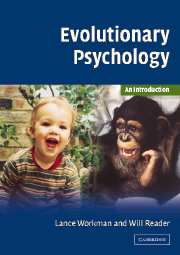Book contents
- Frontmatter
- Contents
- List of figures
- List of tables
- 1 Introduction to evolutionary psychology
- 2 Mechanisms of evolutionary change
- 3 Sexual selection
- 4 The evolution of human mate choice
- 5 Cognitive development and the innateness issue
- 6 Social development
- 7 The evolutionary psychology of social behaviour – kin relationships and conflict
- 8 The evolutionary psychology of social behaviour – reciprocity and group behaviour
- 9 Evolution, thought and cognition
- 10 The evolution of language
- 11 The evolution of emotion
- 12 Evolutionary psychopathology and Darwinian medicine
- 13 Evolutionary psychology and culture
- Glossary
- References
- Index
- References
11 - The evolution of emotion
- Frontmatter
- Contents
- List of figures
- List of tables
- 1 Introduction to evolutionary psychology
- 2 Mechanisms of evolutionary change
- 3 Sexual selection
- 4 The evolution of human mate choice
- 5 Cognitive development and the innateness issue
- 6 Social development
- 7 The evolutionary psychology of social behaviour – kin relationships and conflict
- 8 The evolutionary psychology of social behaviour – reciprocity and group behaviour
- 9 Evolution, thought and cognition
- 10 The evolution of language
- 11 The evolution of emotion
- 12 Evolutionary psychopathology and Darwinian medicine
- 13 Evolutionary psychology and culture
- Glossary
- References
- Index
- References
Summary
Key concepts universal emotions, emotional expression, emotional experience, emotion and motivation, James–Lange theory, limbic system, amygdala, orbitofrontal cortex, lateralisation of emotions, autonomic nervous system, display rules, preparedness theory, positive and negative emotions
Evolutionary psychologists maintain that the mind was designed to solve specific problems that our ancestors faced on a regular basis. If this is the case then, in addition to cognitive mechanisms, surely emotions also serve an adaptive purpose. Such a notion can be traced back to Darwin, who in 1872 argued that emotional expressions are common to all cultures. Following a century when this claim was either disputed or, more commonly, ignored, most psychologists today accept that, at least, some basic expressions are shared by all cultures. But such a conclusion begs a number of further questions. If certain emotional expressions are universal then this suggests that they are adaptive – but how can a facial expression aid survival and reproduction? Moreover, if we all express basic emotions in the same way does this mean that we all experience emotions in the same way? If we do, how might these specific internal states also be adaptive? In this chapter we consider the evidence that emotions are innate and universal from three areas of research – comparisons between different cultures, comparisons between ourselves and our primate relatives and the neurological bases of emotions. Finally, we examine the proposed functional explanations for specific emotional states.
- Type
- Chapter
- Information
- Evolutionary PsychologyAn Introduction, pp. 279 - 306Publisher: Cambridge University PressPrint publication year: 2004



